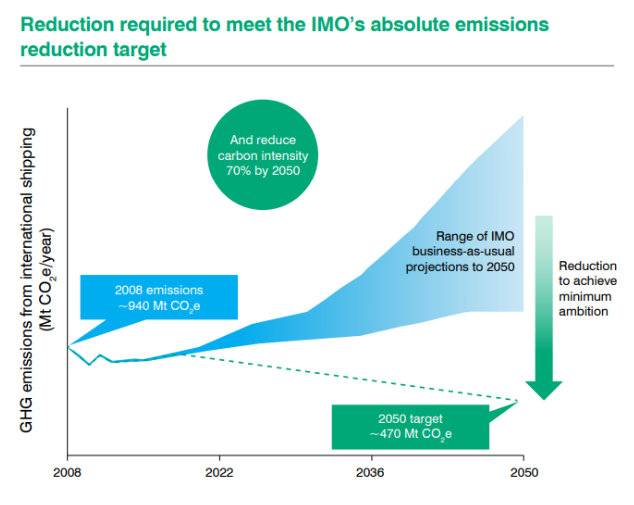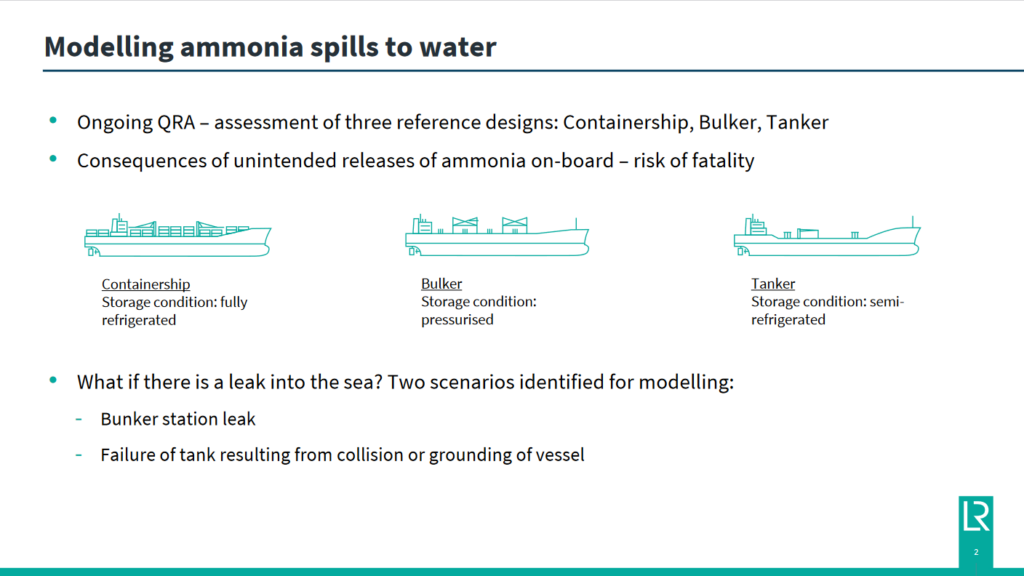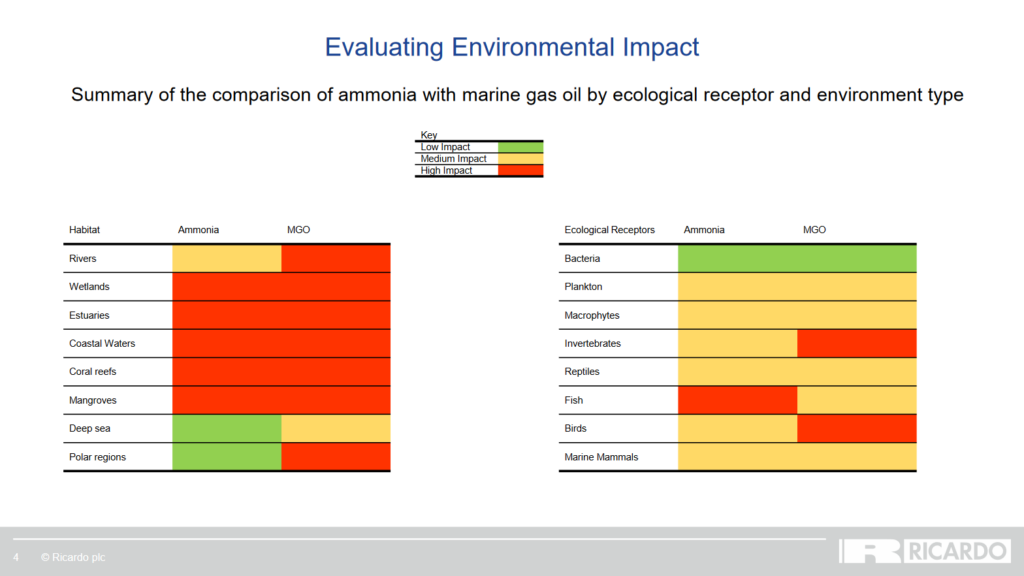Quantifying the environmental impacts of ammonia at sea
By Sofia Furstenberg Stott on March 09, 2023
In last month’s episode of Maritime Ammonia Insights, we explored the findings of a new, landmark environmental study. Ammonia at Sea: Studying the potential impact of ammonia as a shipping fuel in marine ecosystems was co-written by The Environmental Defense Fund (EDF), Lloyd’s Register Maritime Decarbonisation Hub (LR MDH) and Ricardo. AEA Maritime Director Sofia Furstenberg Stott was joined in discussion by representatives from each of the co-authors. You can access the speaker’s presentations here.
Setting the scene, knowledge gaps

Marie Hubatova (Director of Global Shipping, EDF) set the scene, describing the drivers for new fuels in the maritime industry. The increasing greenhouse gas reduction ambitions from the International Maritime Organization will be partly satisfied by increasing ship efficiency. However, to truly decarbonise, the industry will need to adopt fuels which are low carbon both in production and consumption. Ammonia satisfies such criteria, particularly as it can be produced from renewable feedstock without carbon, is more manageable to store at density than hydrogen and has been a maritime cargo for many decades. Ammonia plays a major role in the majority of global decarbonisation forecast models – including those for maritime fuel.
The challenges with ammonia and other new fuels should be seen in context. The world has taken over 100 years to achieve today’s competency with handling conventional, fossil fuels. But we must follow a far steeper learning curve for new fuels. Shipping also has a long asset life to consider as ships built this decade will still be in use up to 2050. So, knowledge is required quickly to enable policy makers to understand full risk and opportunity profiles.
So, what are the critical knowledge gaps? Ammonia toxicity needs to be understood for crew health but also for communities and shorelines. Further to this we need to understand effects of chronic leakage for nitrogen deposition, climate, and other impacts. On the emissions front, Marie pointed out that mitigations for N2O and NOx emissions from ammonia combustion will not be understood until sufficient engine tests are completed. Another emissions quandary was raised by Samie Parkar, who explained that – because it falls within the greater London area – the Port of London will have to take an extra set of air quality standards into account when assessing the use of ammonia fuel.
Accidental spills: modelling the effects
Samie Parkar (Decarbonisation Risk Specialist, LR MDH) explained the input to this study from an existing joint project being undertaken by his organisation and The Maersk McKinney Møller Center for Zero Carbon Shipping.

Ammonia at Sea (Feb 2023).
Together, they have performed extensive quantitative risk assessments for accidental ammonia release, covering three ship types with various onboard storage solutions: container ship with fully refrigerated storage, bulk carrier with pressurised storage and a tanker with semi-refrigerated storage. The modeling also covers two incident types: a leak from the ship side of a bunker hose string, or a larger leak from a tank breach due to a major incident such as collision. When undertaking a literature review, the pair found limited data covering actual spills or practical trials. The United States Coast Guard did carry out practical tests in the 1970s, discharging ammonia to water in a laboratory, a swimming pool, and a lake. They observed a spreading pool of boiling liquid, some of which dissolves in water until such time as equilibrium is reached across the chemical equation:
NH3Aq + H2Ol = NH4Aq + OHAq
The Coast Guard determined that about 70% of the ammonia dissolves, but some will persist in the water. LR MDH and the MMM Center’s project undertook a PHAST-based assessment using the Raj & Reed ammonia water interaction model. They modelled scenarios for the different ship configurations with varying wind and weather conditions and included gas cloud dispersion prediction. They also modelled for an equivalent MGO (marine gas oil) spillage in each scenario.
The size of the spreading liquid pool and gas cloud data were of prime interest. It was found that weather conditions have a significant impact on both. Not surprisingly, the results indicate that a hole in a fuel tank has the highest impact potential – but also the lowest probability. A rupture of a bunker transfer hose is far more likely, and would occur in the milder weather conditions seen in a port. Average weather conditions in the port of Rotterdam were used for in-port scenarios, but it was recognised that conditions may vary greatly in other areas. It was also noted that the modelling did not include water pH, temperature, or salinity, two factors which can have considerable effect upon the residual ammonia remaining in the water. When asked what more needs to be done, Samie recommended more large-scale, live test releases need to be conducted, including factors such as salinity, pH and temperature. Such testing will improve performance of this and future models, and give the industry valuable data to work from.
Ecological impacts

Steve Coates (Associate Director, Ricardo PLC) elaborated on the toxicity effects of ammonia, building upon his own considerable experience in such research. Ricardo focused on ecological areas including rivers and estuaries, and their receptor (inhabitants) such as plankton, invertebrates, macrophiles, fish, birds and reptiles. Key impacts are from the un-ionised ammonia, which can cause significant fish mortalities as they actively absorb the chemical through their gills. Sensitive areas such as coral reefs and mangroves are also at particular risk. At some ammonia concentration levels, increased algal growth may lead to deoxygenated water, but effects vary at other concentration levels.
In comparison with MGO (marine gas oil), the report quantified areas and species for high and low potential impact. A summary of the results can be seen on the right, with ammonia and MGO having similar predicted impacts on different areas and inhabitants. Again, there are a limited number of existing research sources and most studies have focused on land-based runoff sources for ammonia. Steve mentioned that this study did not cover environmental loading in the wider environment – “environmental fate” issues. His advice was for further research toward appropriate regulatory measures including overall broader HSE measures. He also suggested that nitrogen loading for algae blooms etc., be further investigated. When asked about resolving the lack of evidence-based knowledge for large spill events, Steve flagged the emerging potential for machine learning in relation to ecotoxicological studies that may support the development of threshold values.
Lauren Dawson (Senior Water Quality Technical Specialist, Ricardo PLC) commented on the pH, temperature and salinity question when asked if there are some areas just too sensitive to consider introducing risk of an ammonia spill. She made the point that in some areas such as mangroves, these factors may change considerably between seasons and even diurnally, but we don’t have any evidence-based material to work from currently. Regarding any scale effects to consider, including in comparison to other maritime fuels, Dawson noted that different environments and event types were considered but that more work remains for this comparison. When asked to elaborate on further effects on un-dissolved ammonia (apart from ingestion through fish gills) Dawson raised a study by Mills et al which pointed to ammonia-induced anoxia in sea(river) bed sand affecting developing fish eggs which attenuated their later development. Coates added that there are also developmental effects upon shellfish.
Finding the balance
During audience questions the panelists were asked their opinion on how, seeing as we don’t have 100 years to learn the fossil fuel lessons, we should tackle finding a balance between scaling new fuels while properly understanding their environmental impact. Parkar pointed out that there are many transferable learnings from fossil fuels, so we are not starting completely from scratch, so this means a potential shortening of timescales. Similarly, Coates referred to new and advanced learning tools which can accelerate the rate of research progress. Hubatova, speaking more holistically around maritime fuel transition, noted that the shape of the decarbonisation curve to 2050 as a cumulative issue is of critical importance. So, we should focus on what we can do now to impact the curve as soon as possible. For now, the focus for ammonia should be on rigorous engine testing so that we can more accurately understand what kinds of emissions we may need to mitigate.
For takeaway remarks, the panel noted the need to support species-specific research and the need for concurrent build out of safety measures. They highlighted that the Ammonia at Sea report is being incorporated with discussions around ammonia safety at IMO, and as such is spurring calls for further research. Indeed, they recognised the key perspective being that of global collaboration, and work such as theirs being essential to properly advise appropriate policy.
Feature image source: Lloyd’s Register Maritime Decarbonisation Hub website